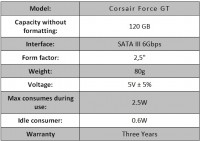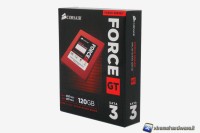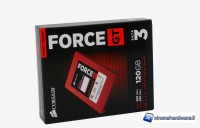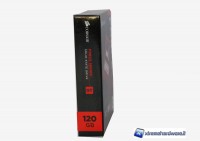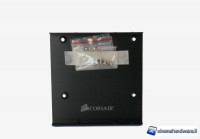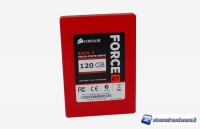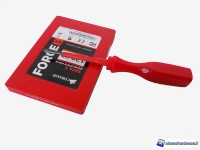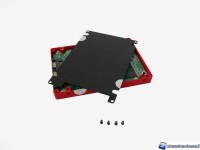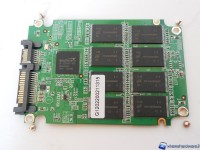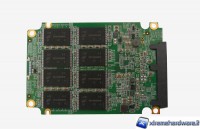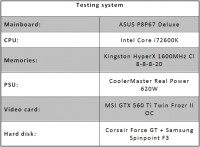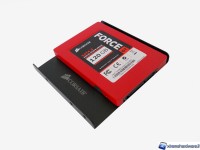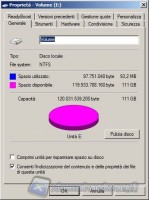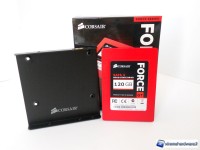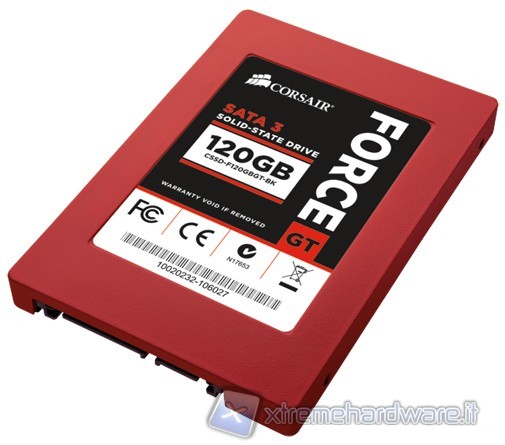
In this review we will test the current Corsair's high-end proposal regarding the SSD industry. Equipped with 6Gb/s SATA III interface, fully supported by the new SandForce SF-2200 controller series, the Corsair Force GT is currently the highest performing Corsair SSD with well 555MB/s declared read, 515MB/s write and well 85,000 IOPS with regard to the 120GB version we're going to test in this review.
Corsair was founded in 1994 by Don Lieberman, John Paul and Andy Beekley, headquartered in Fremont, California. Since the dawn it has always been a point of reference for the PC market, initially through the production of COAST (Cache-On-A-Stick) modules, or modules used in the old computer to implement the second-level cache (L2), and later in the production of real RAM memory modules for PCs. Due to the success with products like the Corsair XMS series and the Corsair Dominator series, the company has entered the elite of gamers and overclockers, and then was able to expand its product range by producing All-in-One liquid cooling systems, power supply units, SSD drives and finally Full Tower and Mid Tower cases, including the Corsair Graphite 600T Special Edition which we recently video-reviewed.

With the advent of solid state drives technology in the desktop market, the California company has not remained aloof and offers various types of drives addressed to as many types of users. The initial proposals, or the Nova and Force series, were once valued for their excellent performance. The success was also confirmed by the following series, Performance 3 and Force 3, characterized by compatibility with the new SATA 6Gbps III. Recently introduced, the Force GT series showed at the CEBIT 2011, looks like the top of the range solution of the Californian company and is characterized by above-average performance through the use of the SandForce SF-2281 chip.
Tecnical specifications
As for GT Force series, Corsair offers three models with different capacities, in particular there is the 60GB, the 120GB version (which we will cover in this review) and the 240GB version. For more information on Force GT models in the series, please consult the official Corsair website:
http://www.corsair.com/solid-state-drives/force-series-gt.html
The declared technical specifications of the model we reviewed are as follows:
Regarding performance, the manufacturer declares the following data:
As you can see from the table, the performances are very respectable, about twice the SATA II SSD and above those seen with a few SATA III SSD. Also we mention the high number of IOPS, well 85,000.
The manufacturer also declares an average life of the drive of about 2 million hours.
So we're going to test the drive using a variety of programs to measure performance in read and write of HDDs and SSDs. We will see, then, if the characteristics declared by the parent reflect the actual performance of the drive.
Packaging and Bundle
The Corsair Force GT is sold in a carton with dimensions of 135 X 110 X 30 mm and is characterized by a black and red color, as well as for the GT and GTX Dominator RAM Series memories. The graphics used for the packaging, apart the coloring, is very similar to that used in the Corsair Force 3 SSD. As with the basic version, in fact, even the GT version of the box has a picture of the SSD on the front, the message inherent the model in transversal direction on the right side and the characteristics of the disk in question at the bottom.
Specifically, among the features include the capacity, the connection used, the size of the SSD and the claimed performance in read and write.
In the package, in addition to the drive, there are the mounting screws and an adapter from 2.5" to 3.5" of black metalized color with the Corsair inscription and logo placed transversely, so as not to be covered once mounting the drive.
The SSD has a very aggressive design, thanks to the red color of the cover. The sticker, placed on the body, shows us the serial number of the model, the product key and the drive capacity. The bottom has a black color that will go very well with many enthusiast motherboards on the market today, but also with the Corsair GT and GTX RAM. The bottom features two warranty stickers placed on two edges and four small screws to disassemble the drive, removing them you will have access to the PCB.
On the PCB is easily recognizable the SandForce SF-2281 chip, the same used for the Corsair Force 3 series, and the 16 NAND memory modules used (8 per side) in 4 rows of 4 modules each. The modules used are branded Micron and their code is 29F64G08CBAAB, unlike those used for the Corsair Force 3 changes the last letter from B to A. Overall, the PCB is clean enough, although all components are installed on a very small board.
Video Unboxing
http://www.youtube.com/watch?v=eS6EqjWJas8
The heart of Corsair Force GT: SandForce SF-2281
The models presented at CeBIT 2011 by Corsair, including the Corsair Force GT, are characterized by the use of a second generation SandForce chip, which allows you to use the 6Gbps SATA III controller; specifically the Force GT features a SandForce SF-2281. Among the main features of this new controller is the ability to simultaneously access the 8 NAND Flash modules, each module has a capacity of 8GB.

The NAND flash memory cells present on the PCB of the drive we're going to review are 16, divided into two groups of 8, one on each side of the PCB. The memories, MLC type (Multi Level Cell) have a 25nm production process and totally provide 120GB of capacity (8GBx16=128GB). The remaining 8GB are devoted to disk protection in case of a failing Flash Block. The NAND flash memory cells are certified by ONFI (Open NAND Flash Interface), which simplifies the interaction of memory chips in desktop products. The use of 25nm cell while leading to an increase in space devoted to over provisioning, or the additional space dedicated for the replacement of a dead cell, the other leads to a slight decrease of life of the chips that are less lasting than those produced in 34nm.Making use of 16 modules NAND memory instead of the classic 8 (one per channel) might seem a disadvantage, but in reality, since the NAND memory cells employ a certain amount of time to retrieve the data, while one is engaged in the operation research, the other can perform other operations, so as to saturate the communication channel, thus acting in parallel; thereby optimizing the use of the canal, you experience superior performance in both read and write. Thanks to the many technologies implemented by the second generation SandForce controller, the possibility of loss of data due to corruption is almost nothing compared to traditional HDDs.
Like all other last generation SSDs also the Corsair Force GT supports the TRIM function and therefore the performance gap that the first models of SSDs experienced with the passage of time during read and write operations has been virtually wiped out.
The second generation of SandForce controllers also improves the number of input/output per second (IOPS) compared to the previous versions of the same controller; the model we reviewed, reaches the 85K IOPS. Besides this, the SF-2281 controller natively supports garbage collection; this function is independent of the operating system as opposed to the TRIM technology, it takes note of the areas of memory not allocated from a process and makes them available again. In the case of SandForce controllers, the garbage collection function was called Recycling and has been implemented in order to have less impact on the durability of flash memory. Another very important feature of the SF-2281 controller is a suite of technologies called DuraClass (of which SandForce is the sole owner). It integrates the DuraWrite functionality, which streamlines the process of writing the flash memory, with similar effect to that of wear leveling.
The SF-2281 controller, like its predecessors, continues to support the RAISE (Redundant Array of Independent Silicon Elements) functionality similar to RAID, but that increases the integrity of data written and a better efficiency than RAID 1. Exploiting chips parallelism handled by the controller, data is distributed across multiple chips, while improving performance and providing greater protection in case of loss of data blocks. In fact, if the data were stored contiguously, the likelihood of being able to correct errors in a block is dramatically reduced.
Test system and metodology
The test system used to test the Corsair Force GT is based on Intel P67 chipset; the motherboard is an Asus P8P67 Deluxe B3 step, free from the SATA II chip problem detected in step B2. Although the SATA II connection speed is limited to the declared 3 Gbit/s (384MB/s) we have done likewise the tests using that connection, because the SATA III devices are backwards-compatible with the previous standard.
The system used is as follows:
The OS is Windows 7 Ultimate X64, while for the drivers we have taken steps to upgrade Intel Rapid Storage to the latest release, i.e. 10.05, in order to optimize the results obtained in the tests.
Apart from updating drivers, we proceeded to tweak properly the OS through two small steps in order to preserve the unit from future degradation and to optimize performance. Specifically, these tweaks are disabling the defragmentation of the drive by the operating system and disabling indexing of the drive through the Properties menu of the drive.
All tests were performed using a completely blank drive without partitions, and have also been performed several times in random order, so you have an average result very precise.
Once detected the drive in Windows 7, the system recognizes 111GB available.
.
CrystalDiskMark 3.0.1
CrystalDiskMark is a very useful software to measure performance in reading and writing sequentially (sequential) and random (random), thanks to full support for NCQ (Native Command Queuing). The order of the IOPS is optimized to improve performance input/output with a Queue Depth (file tail) of 32; this test allows you to observe the behavior of the drive when transferring many small files.
The latest version of the program currently available is 3.0.1. Recall that in versions 1.0, 2.0 and 2.1 were found critical bugs are therefore strongly discouraged.
In this test we did not get thrilling performance, especially in normal mode. However, we will consider only those tests relating to performance in 4K QD32. However the results in the sequential test in 0-fill mode are quite close to those declared.
SATA II 3Gb/s

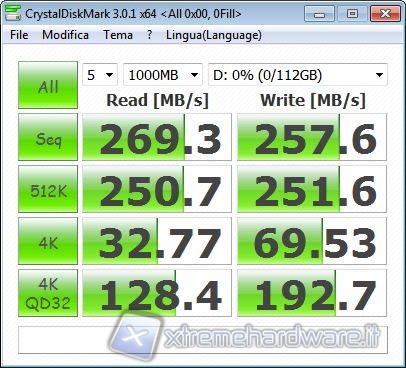
SATA III 6Gb/s


HD Tune 4.60
HD Tune is an utility for hard drive and SSD with many functions, it can be used to accurately measure the performance of the drive, for errors finding, to check the vital status of the drive, to securely erase data and much more. The version we use is the latest available at the moment and it's 4.60. The program is available in two versions, a freeware (HD Tune) and a paid version (HD Tune PRO), in our case it was necessary to use the PRO version because it is the only one capable of measuring the writing drive performance.
In this test we highlight the remarkable performance of the Corsair drive both in reading and writing:
SATA II 3Gb/s
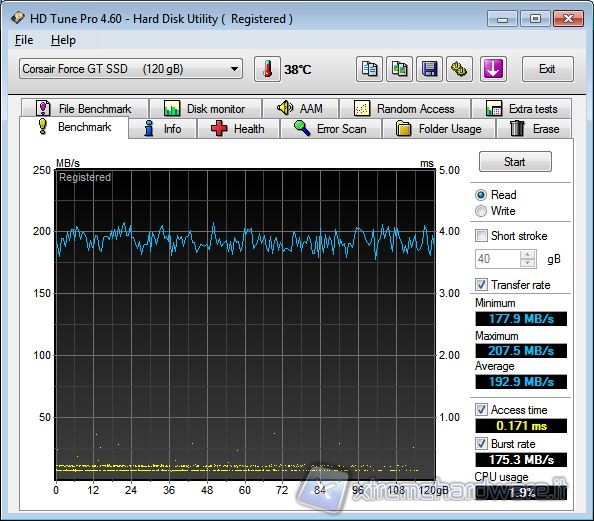

SATA III 6Gb/s
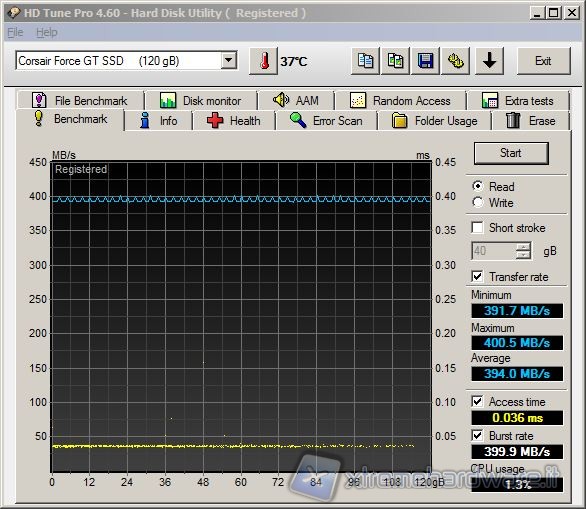
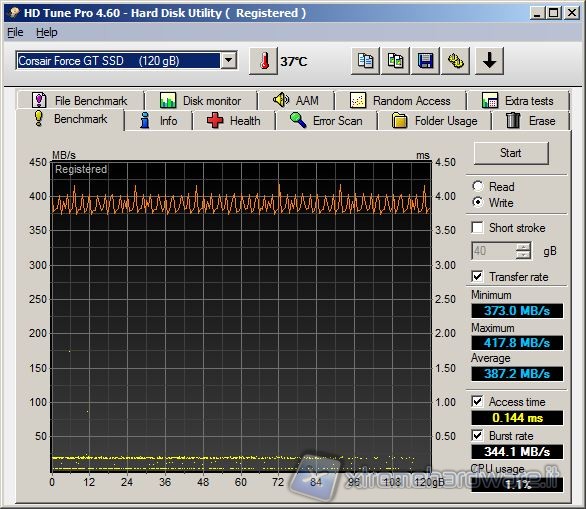
Also with regard to the number of IOPS the drive has shown respectable performance
SATA II 3Gb/s
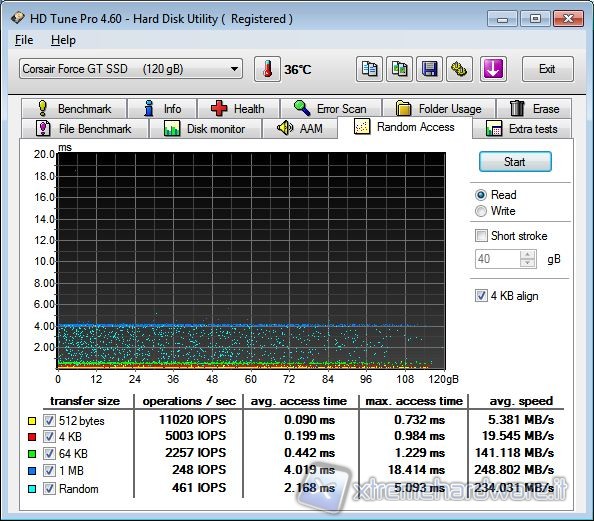
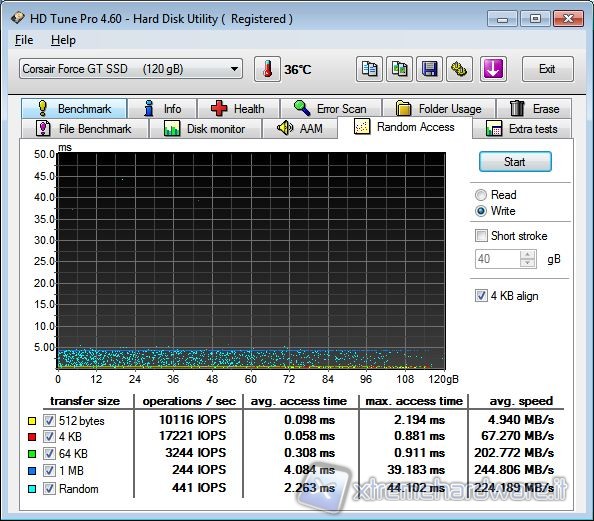
SATA III 6Gb/s
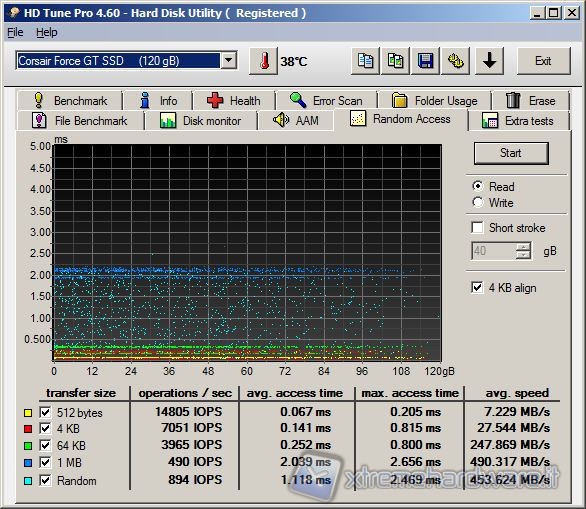
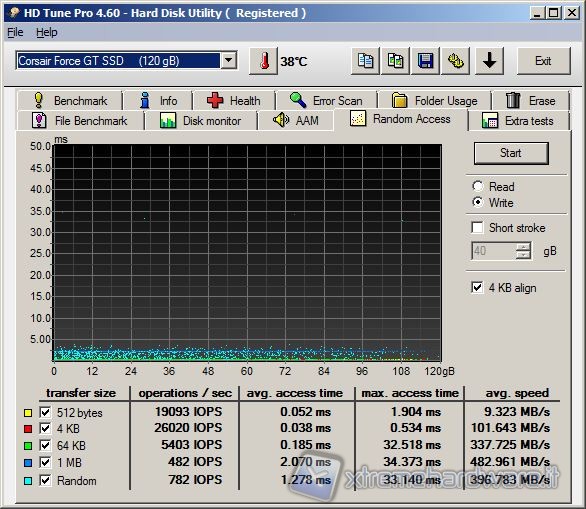
AIDA64
Hungarian AIDA64 is a suite of more than 50 small software designed to test the status of our PC. Besides indicating the state of the operating system, motherboard, CPU and many other devices, it also allows you to perform benchmarks on the memory, the cache and the disks/drives. AIDA64 is available in two versions, Extreme Edition and Business Edition, both versions are freeware version, and once finished the trial period of 30 days many functions will be disabled if the product is not registered.
Apart from the write performance, the drive has performed very well with excellent results:
SATA II 3Gb/s
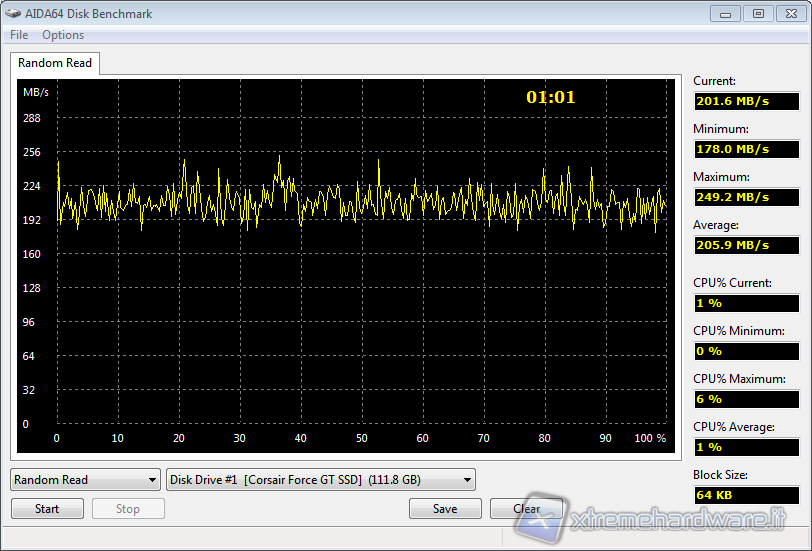
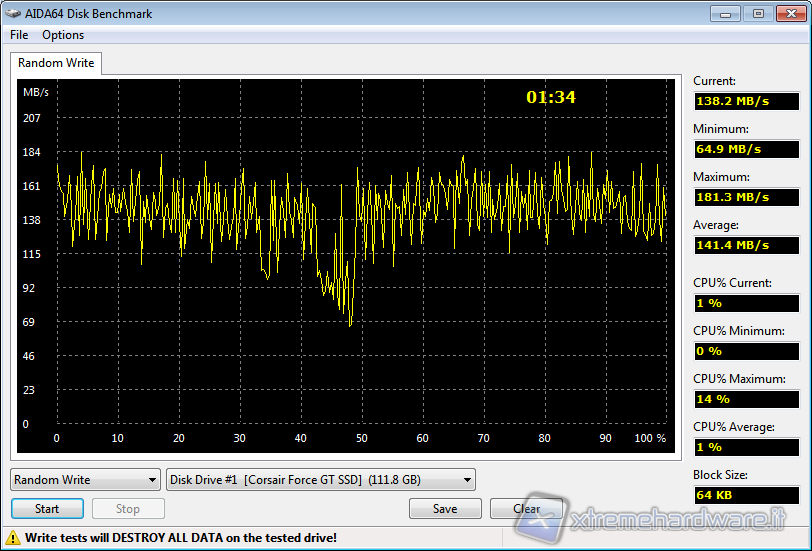
SATA III 6Gb/s
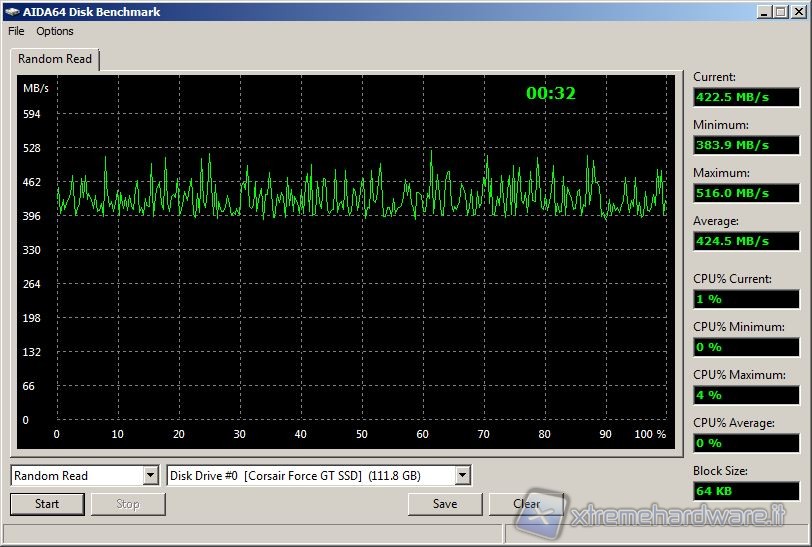
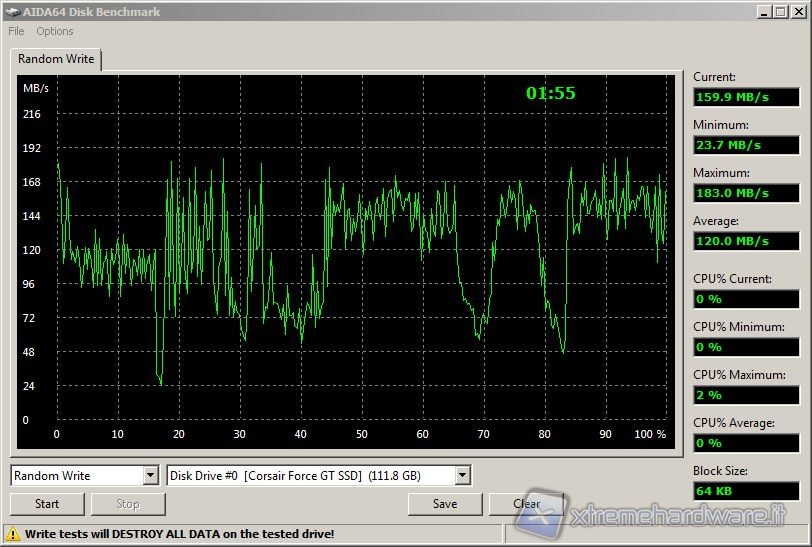
ATTO Disk Benchmark
ATTO is a free benchmark that executes simple read and write tests in batch mode employing a Queue Depth (files in the queue) of 4.
Here we are at the truth moment, the performance results declared by its manufacturer have been obtained using this software, judging from the graph we can say that the performance of the drive is about 520MB/s in writing and more than 550MB/s in reading. The results thus obtained are exceptional, even higher than those declared.
SATA II 3Gb/s

SATA III 6Gb/s

AS SSD Benchmark
AS SSD Benchmark is another free benchmark specifically designed for SSD. It performs its synthetic tests without using the operating system cache that is heavily influencing the results of the transfer rate, it also determines the access time of the drive using the full capacity of the drive itself, all tests are carried out using non-compressible data.
Through this test we have shown good results in copy mode and compression mode:
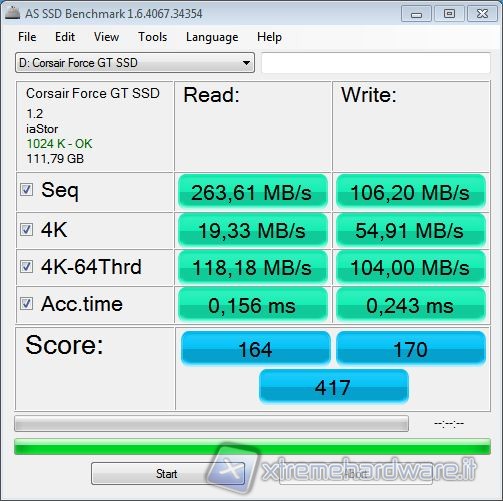
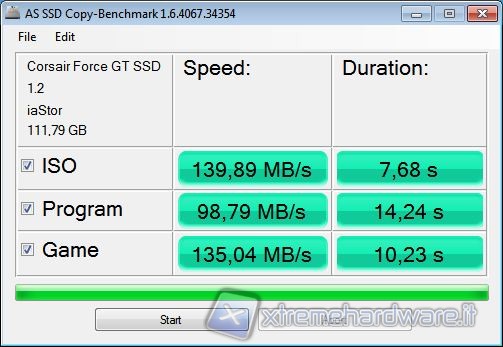
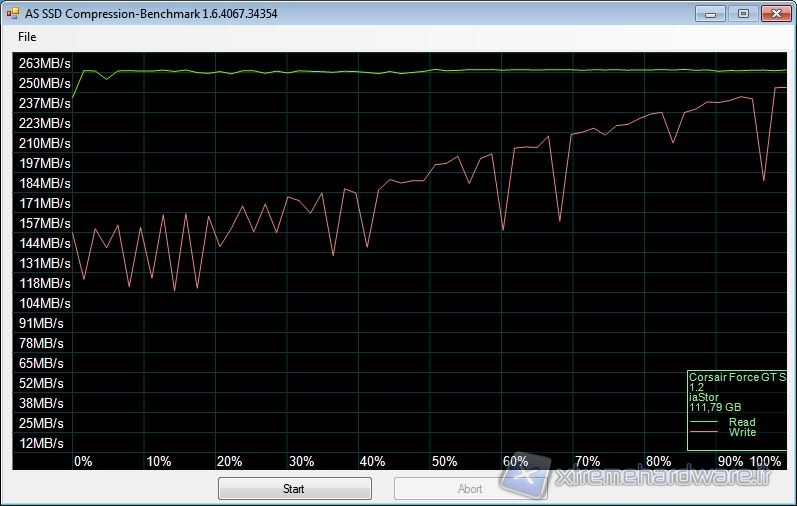
SATA III 6Gb/s
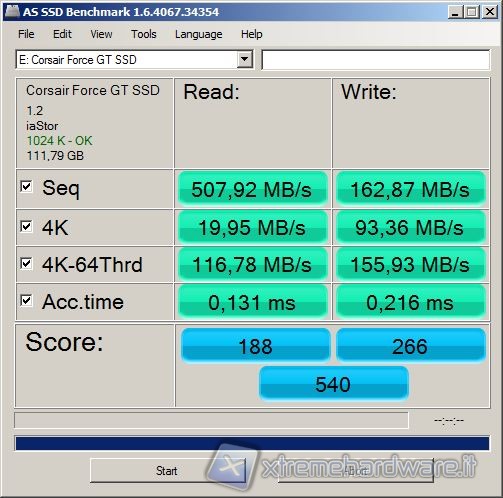
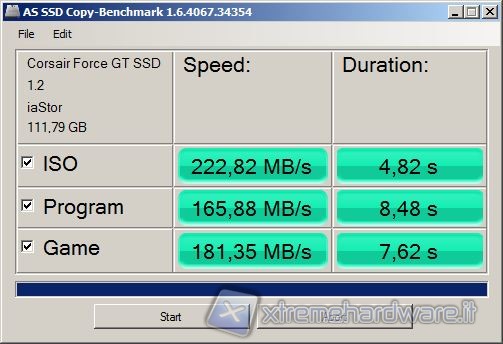
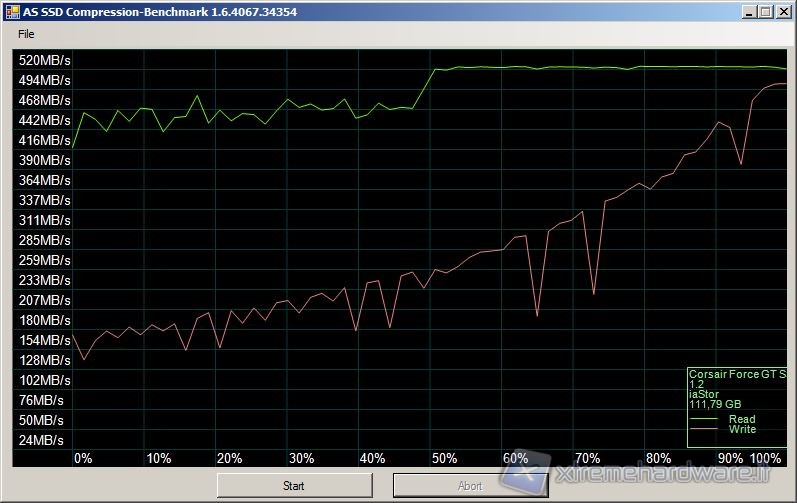
Conclusions

| Performance: | |
| Quality/Price ratio: | |
| Overall: |
As usual with the Corsair products we can not express but a positive opinion. In this case, the Corsair Force GT not only looks like one of the fastest desktop SATA III SSD currently on the market, but its design will be much appreciated by the hard gamers and modders, which feature top of the line mainboard with the same staining.
The performance of the Corsair Force GT are at the top in its class and with additions of features and technologies to maintain high performance over time, thanks to the SF-2281 SandForce controller, the SSD shows no obvious weaknesses.
That's not all. The price of the drives we tested, with a capacity of 120GB, is "only" 210 € against 260 € of his closest rival, the OCZ Vertex III MAX IOPS 120GB. The performance of the Force GT is even larger than those reported for the rival SSD, thanks to a higher number of IOPS: well 10,000 more.
With a great quality/price ratio, top performance, a very nice design and high build quality, we can only give a deserved full marks, as the Corsair GT Force is an excellent drive.
PROs:
- Top performances
- Aesthetically very neat
- 85.000 IOPS
- Very good price
CONs:
-
Nothing to report
Thanks to Corsair for the sample object of the review
Giovanni Abbinante
Translated by Marco Comerci
